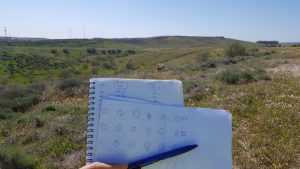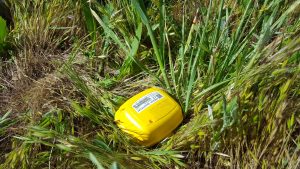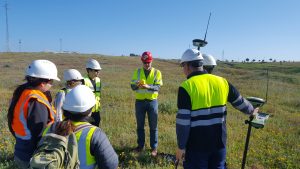On 28 and 29 March, at the Las Cruces mine[1] north of Seville in Andalusia, a seismic network of 132 geophones covering an area of about 1 x 2 km was installed for one month to register ambient seismic noise. This configuration will be used to see through and map a 250m thick layer of marls, and to image the massive sulphide ore body 200-400m below the surface. This joint passive seismic data project results from collaboration between two Horizon 2020 funded projects, INFACT and PACIFIC.

Deployment of the geophones across the Las Cruces mine. Photo: Leila Ajjabou
The project teams use the passive seismic technique to look inside the Earth’s crust and detect ore deposits, using geophones deployed at the surface. A geophone, as the name indicates, is a device that ‘listens to the Earth’ by recording seismic waves.

Geophone. Photo: Leila Ajjabou
Seismic “noise” is generated continuously at the surface of the globe, due to the interaction between the atmosphere, the oceans and the solid Earth (seismic waves with frequencies below 1 Hz), and also to human activities due to water pumping, trucks, trains, wind turbines… (frequencies higher than 1 Hz). This ambient seismic noise reads the fingerprint of the subsurface and allows the passive imaging technique to obtain a picture of the Earth’s 3D tomography.
PACIFIC members (Rosemary Fayjaloun – scientific project manager and Coordinator for PACIFIC project, Dan Hollis – CEO of SISPROBE, and Laura Pinzon – PhD student at Université Grenoble Alpes), in collaboration with INFACT partners (Leila Ajjabou – Project coordinator of INFACT at Helmholtz Institute Freiberg, Joan-Marie Blanco – Post Doc in Geophysics at Helmholtz Institute Freiberg, Elena Kozlovskaya – Professor of applied geophysics at the Oulu Mining School, Isla Fernandez – CEO of Geognosia, and the team of Cobre Las Cruces) visited Cobre Las Cruces last week, and deployed the geophones at the mine site. All attendees participated in the planning and deployment, with the valuable and generous support of the Las Cruces company.

INFACT and PACIFIC partners installing a geophone. Photo: Leila Ajjabou
PACIFIC will collect the geophones at the end of April and process the data to obtain a tomographic image of the targets at Las Cruces.
As for all INFACT activities, the data acquisition was preceded by consultation and supply of information with local stakeholders. Passive seismic, a low-impact exploration method, was presented to the population as a tool contributing to a more respectful mining model. This fits perfectly with INFACT’s ambition to establish a set of permanent, accessible reference sites throughout Europe to trial and assess the technological and social performance of existing and emerging innovative, non-invasive exploration techniques.
[1] The Las Cruces mine exploits massive copper sulphides in the volcanics of the Spanish Pyrite Belt. The company Cobre Las Cruces is part of the First Quantum group.

